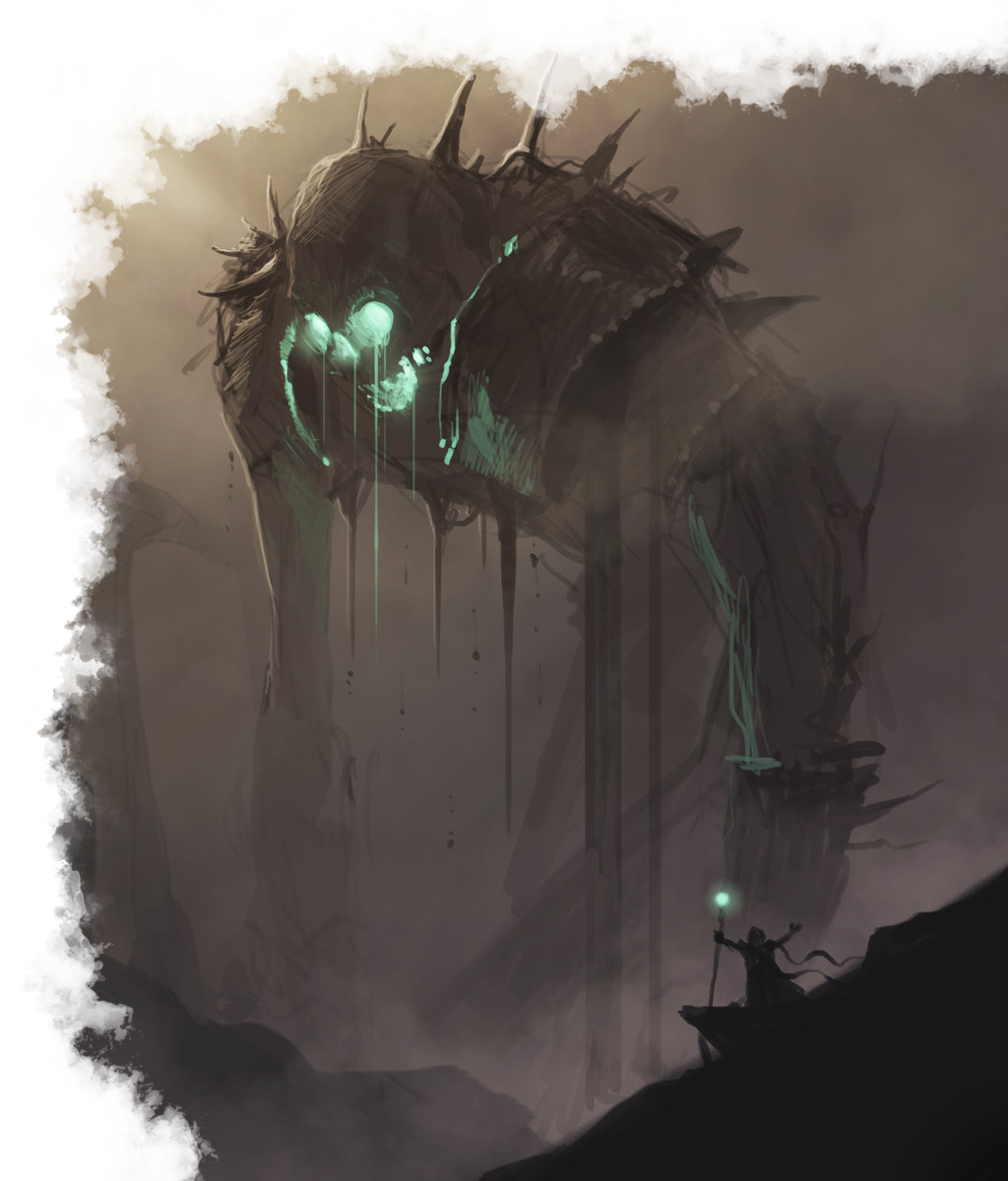Necromancer
A handsome Elf male in a white robe takes pause in the middle of a battle to survey the scene before him. Seeing a nearby footman losing ground to a bloodlusting Orc, he touches the corpse of a nearby Worg, which rises from the afterlife and lunges at the green beast.
A Tiefling in black leather armor raises her sword to parry the wild swing of a cackling Gnoll. As her free hand grabs the creature’s unarmored wrist, it lets out a yelp as a green misty substance flows into the Tiefling’s palm and out of a cut on her forearm - a cut that slowly starts to close.
Seeing an Ogre’s giant club about to come down on him, a tired warrior closes his eyes and awaits death. A howl sounds, and the fighter opens his eyes: he sees the giant flailing around wildly, grasping its face. Standing behind it is a mischievous Gnome, grinning through his beard, holding an open tome.
No matter the approach to combat, necromancers seek to control life and death in all their forms. A natural knack for manipulating the life essences that flow in every living being is what drives each necromancer to commit their nefarious or honorable deeds.
A search for the impossible
If there is one credo that rings true for even the most powerful, it is that all mortals must die - whether sooner or later. These sinister figures, however, prefer later over sooner: necromancers are those who have somehow learned to manipulate the essence of life itself.
Through their techniques, they take it from those they deem undeserving, control it to their own liking, and sometimes even give it to those who could further their efforts. Most necromancers live their life in pursuit of immortality, whether for themselves or a loved one. Though they live by the credo of inescapable mortality, the ultimate goal that their skills are a means towards is often to beat that exact clock they know so well ticks for everyone.
A Unique Talent
Contrary to popular belief, necromancers are not necessarily evil-doers, nor do all of them seek to subjugate others. In fact, some of them seek to use their powers for good: a poor understanding of their skills as well as their use of frightening undead monstrosities has simply led to a more generalized fear of their capacities. In reality, necromancers are a varied set of people. There is, however, one thing all of them have in common: each necromancer has some form of power over the vital essences that move any living creature - and they seek to use this to their advantage. Whether strayed wizards, aspiring acolytes or even blessed priests of gods of life, necromancers aim to achieve their goals by manipulating the very core of any creature's being.
Creating a necromancer
In creating a necromancer, there is one important fact to consider: ‘how did you come into contact with necromancy, and why do you use it?'. Were you a young wizard who discovered their talent for manipulating life essence was more effective than blasting enemies with evocation spells? Did you grow up in a demon-worshipping cult that required the storing of life essence for satanic rituals? Or perhaps the source of your talent is unknown and mysterious? And what is the appeal of Necromancy to your character? Is it simply 'power over others', or did you perhaps lose a loved one to disease and felt the inability to prevent their death frustrating?
Quick Build
You can make a necromancer quickly by following these suggestions. First, Wisdom should be your highest ability score. Make Intelligence your next-highest if you want to excel at spell casting and plan to take up the Creed of Tomes archetype. Choose Constitution instead if you plan to emphasize either the summoning of undead minions or the manipulation of health pools. Second, choose the Acolyte or Sage background. Third, choose the Chill Touch and Thaumaturgy cantrips.
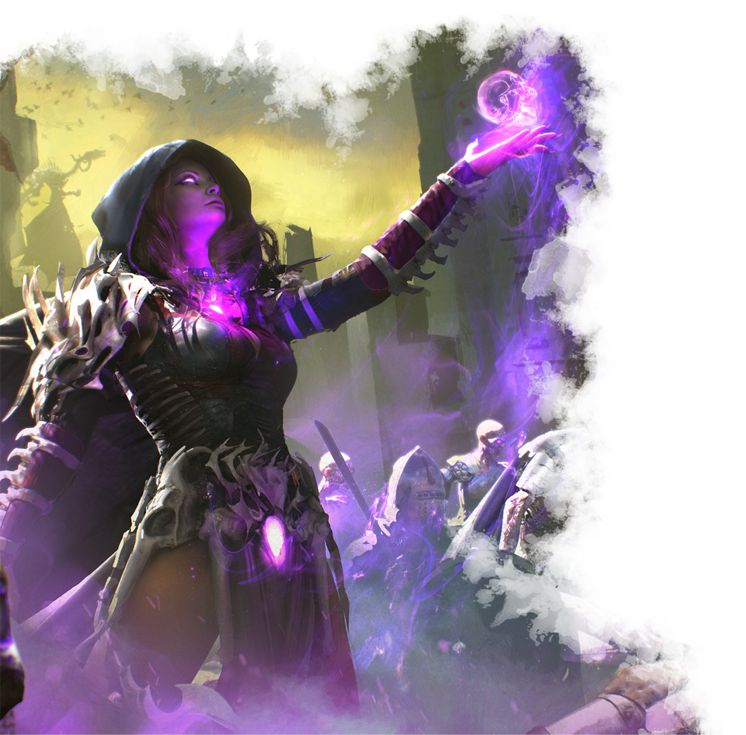
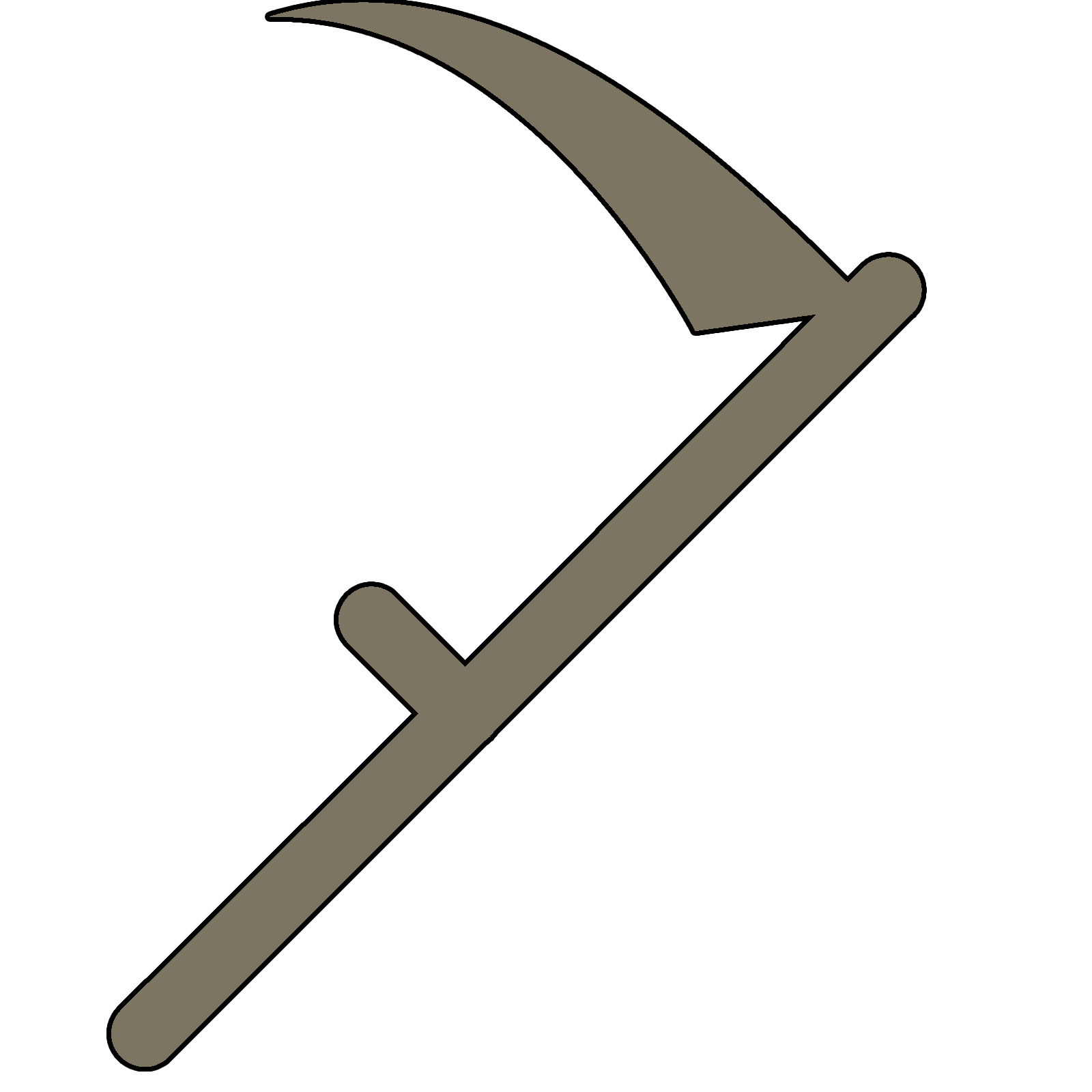
The Necromancer
| Level | Proficiency Bonus | Features | Cantrips Known | Spells known | 1st | 2nd | 3rd | 4th | 5th | 6th | 7th | 8th | 9th | Acumen Known (Creed of Tomes Only) |
|---|---|---|---|---|---|---|---|---|---|---|---|---|---|---|
| 1st | +2 | Spellcasting, Vitality Shift | 2 | 4 | 2 | — | — | — | — | — | — | — | — | — |
| 2nd | +2 | Necromantic Creed | 2 | 5 | 3 | — | — | — | — | — | — | — | — | — |
| 3rd | +2 | — | 2 | 6 | 3 | 2 | — | — | — | — | — | — | — | 1 |
| 4th | +2 | Ability Score Improvement | 3 | 7 | 4 | 3 | — | — | — | — | — | — | — | 1 |
| 5th | +3 | — | 3 | 8 | 4 | 3 | 2 | — | — | — | — | — | — | 1 |
| 6th | +3 | Creed Feature | 3 | 9 | 4 | 3 | 3 | — | — | — | — | — | — | 2 |
| 7th | +3 | — | 3 | 10 | 4 | 3 | 3 | 1 | — | — | — | — | — | 2 |
| 8th | +3 | Ability Score Improvement | 3 | 11 | 4 | 3 | 3 | 2 | — | — | — | — | — | 2 |
| 9th | +4 | — | 3 | 12 | 4 | 3 | 3 | 3 | 1 | — | — | — | — | 2 |
| 10th | +4 | Creed Feature | 4 | 13 | 4 | 3 | 3 | 3 | 2 | — | — | — | — | 3 |
| 11th | +4 | — | 4 | 14 | 4 | 3 | 3 | 3 | 2 | 1 | — | — | — | 3 |
| 12th | +4 | Ability Score Improvement | 4 | 15 | 4 | 3 | 3 | 3 | 2 | 1 | — | — | — | 3 |
| 13th | +5 | — | 4 | 16 | 4 | 3 | 3 | 3 | 2 | 1 | 1 | — | — | 3 |
| 14th | +5 | Creed Feature | 4 | 17 | 4 | 3 | 3 | 3 | 2 | 1 | 1 | — | — | 4 |
| 15th | +5 | — | 4 | 18 | 4 | 3 | 3 | 3 | 2 | 1 | 1 | 1 | — | 4 |
| 16th | +5 | Ability Score Improvement | 5 | 19 | 4 | 3 | 3 | 3 | 2 | 1 | 1 | 1 | — | 4 |
| 17th | +6 | — | 5 | 20 | 4 | 3 | 3 | 3 | 2 | 1 | 1 | 1 | 1 | 4 |
| 18th | +6 | Eternal Youth | 5 | 21 | 4 | 3 | 3 | 3 | 3 | 1 | 1 | 1 | 1 | 5 |
| 19th | +6 | Ability Score Improvement | 5 | 22 | 4 | 3 | 3 | 3 | 3 | 2 | 1 | 1 | 1 | 5 |
| 20th | +6 | Creed Feature | 5 | 23 | 4 | 3 | 3 | 3 | 3 | 2 | 2 | 1 | 1 | 5 |
Class Features
As a necromancer, you gain the following class features.
Hit Points
- Hit Dice: 1d6 per necromancer level
- Hit Points at 1st Level: 6 + your Constitution modifier
- Hit Points at Higher Levels: 1d6 (or 4) + your Constitution modifier per necromancer level after 1st.
Proficiencies
- Armor: Light armor
- Weapons: Daggers, Quarterstaffs, Sickles
- Tools: None
- Saving Throws: Wisdom, Intelligence
- Skills: Choose two from Arcana, Deception, History, Investigation, Medicine, and Religion.
Equipment
You start with the following equipment, in addition to the equipment granted by your background:
- (a) a quarterstaff or (b) a sickle
- (a) a component pouch or (b) an arcane focus
- (a) a priest’s pack or (b) a scholar’s pack
Alternatively, you can choose to start with 4d4 x 10 gp and opt to spend some or all of that money on starting equipment.
Tip for DMs:
If you are using exotic weapons in your game, such as the ones created by Walrock Homebrew, add the iconic 'Scythe' to a Necromancer's standard weapon proficiencies.
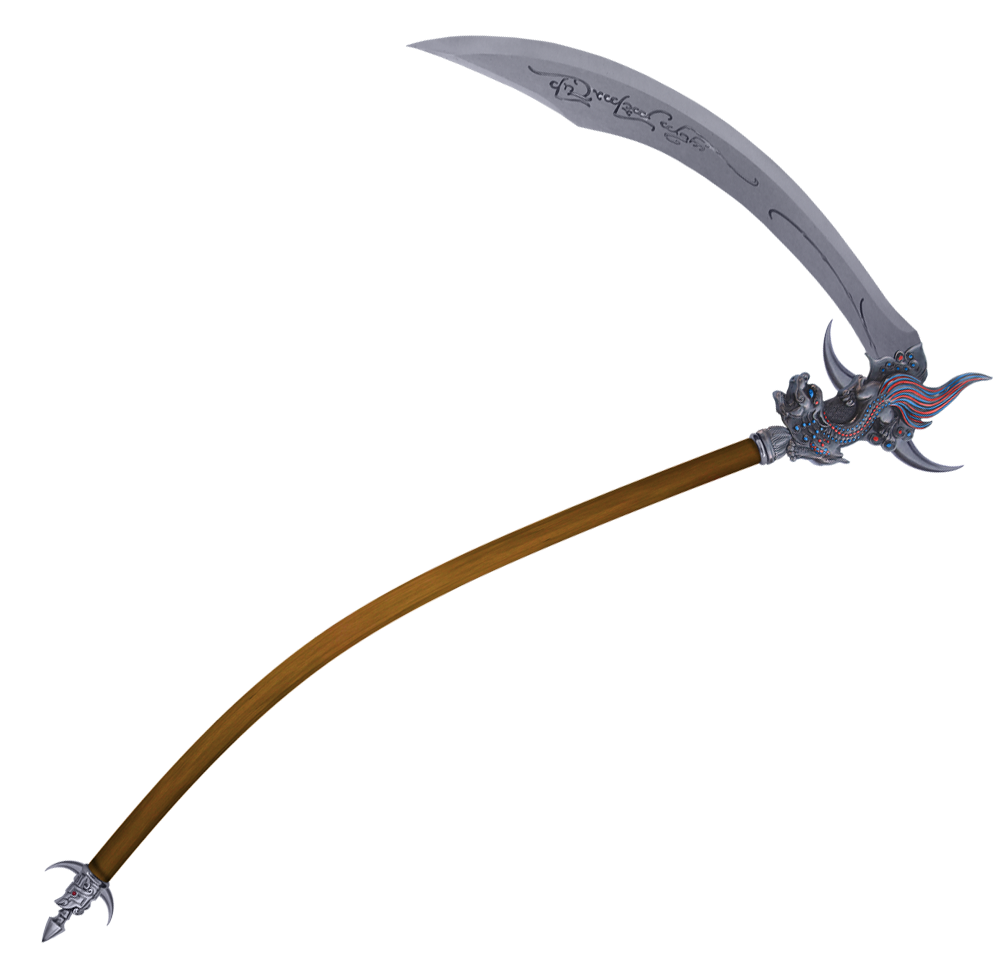
Spellcasting
As a necromancer, the skill to manipulate the life essence of any living being comes naturally to you. Though this skill requires natural talent, the techniques for doing so can be enhanced by studying spells and the arcane.
See chapter 10 of the official player handbook for the general rules of spellcasting and the end of this document for the necromancer spell list.
Cantrips
You know two cantrips of your choice from the necromancer spell list. You learn additional necromancer cantrips of your choice at higher levels, as shown in the Cantrips Known column of the necromancer table.
Spell Slots
The Necromancer table shows how many spell slots you have to cast your spells of 1st level and higher. To cast one of these necromancer spells, you must expend a slot of the spell’s level or higher. You regain all expended spell slots when you finish a long rest.
For example, if you know the 1st-level spell False Life and have a 1st-level and a 2nd-level spell slot available, you can cast False Life using either slot.
Spells Known of 1st Level and Higher
You know four 1st-level spells of your choice from the necromancer spell list.
The Spells Known column of the Necromancer table shows when you learn more necromancer spells of your choice. Each of these spells must be of a level for which you have spell slots, as shown on the table. For instance, when you reach 3rd level in this class, you can learn one new spell of 1st or 2nd level.
Additionally, when you gain a level in this class, you can choose one of the necromancer spells you know and replace it with another spell from the necromancer spell list, which also must be of a level for which you have spell slots.
Spellcasting Ability
Wisdom is your spellcasting ability for your necromancer spells, for your magic draws upon your innate link to the essence of life that sits within all creatures. You use your Wisdom whenever a spell refers to your spellcasting ability. In addition, you use your Wisdom modifier when setting the saving throw DC for a necromancer spell you cast and when making an attack roll with one.
Spell save DC = 8 + your proficiency bonus + your Wisdom modifier
Spell attack modifier = your proficiency bonus + your Wisdom modifier
Ritual Casting
You can cast any necromancer spell as a ritual if that spell has the ritual tag.
Spellcasting Focus
You can use an arcane focus (found in PHB chapter 5) as a spellcasting focus for your necromancer spells.
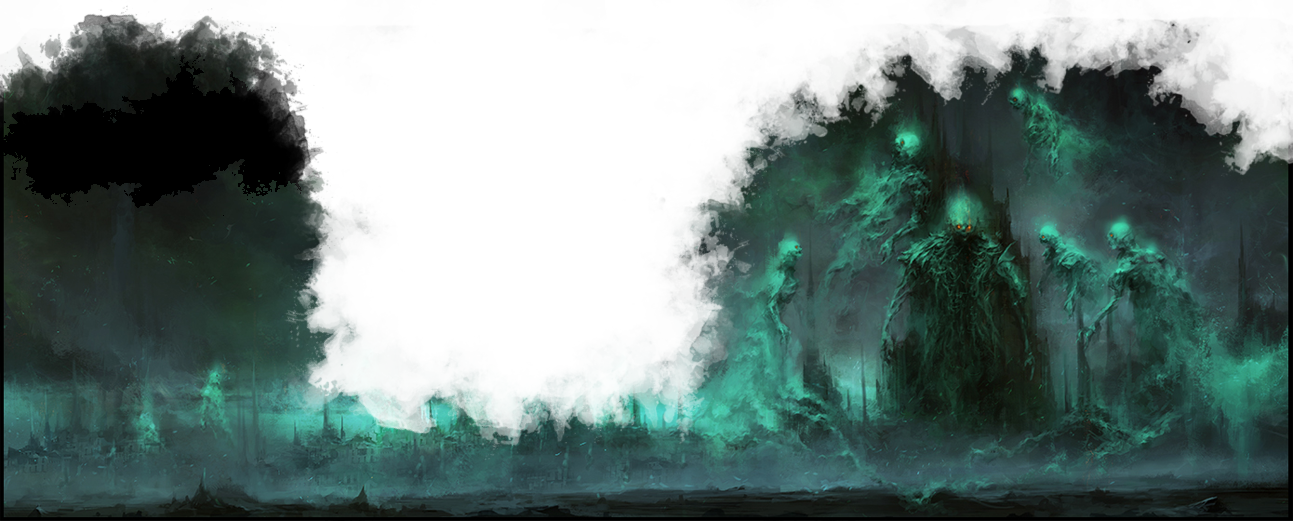
Vitality Shift
All 1st level Necromancers have a certain control over the life forces that flow through each living being. As an action, you may touch a willing creature in order to either drain their vitality, or give them yours. You may take an amount of hit points of up to four times your Necromancer level and either remove it from your target's pool and add it to your own, or vice versa. Hit points transferred this way can not cause either pools to go beyond their maximum amount of hit points.
You can use this feature a number of times equal to your wisdom modifier (minimum of one charge). When you finish a long rest, you regain all expended uses.
Necromantic Creed
At 2nd level, you choose one of three necromantic creeds to adhere to: the Creed of the Departed, the Creed of the Siphon, or the Creed of Tomes. These Creeds give you features at 2nd level and again at the 6th, 10th, 14th and 20th levels. Each creed is detailed at the end of the class description.
Ability Score Improvement
When you reach 4th level, and again at 8th, 12th, 16th and 19th level, you can increase one ability score of your choice by 2, or you can increase two ability scores of your choice by 1. As normal, you can’t increase an ability score above 20 using this feature.
Eternal Youth
At 18th level, you have so much experience manipulating the essence of life that you are able to regain some of your childhood vigor. You become proficient in constitution saving throws, immune to poison and disease, and whenever you use your vitality shift feature, you can choose to also transfer an amount of years of age of up to your Necromancer level between yourself and the recipient.
Necromantic Creeds
Though the basic life-altering skills of each necromancer are at their core identical, practicioners of the skill improve upon it in their own way. This is done through adhering to a certain type of necromantic creed. Depending on the lands and areas a necromancer travels through, a creed can be anything ranging from an underground organization to personal, basic principles any one necromancer chooses to adhere to.
The Creed of the Departed
Though it is much more than just that, one phenomenon is most often associated with necromancy by the common folk: raising the dead. This field is exactly what the Creed of the Departed focuses on. Whether one undead Ogre or a horde of skeletons, those who join the ranks of this creed rely on the assistance of the lifeless to accomplish their goals. Necromancers within this Creed focus on improving their Undead Minions above all else. Since they usually pour some of their own lifeforce into the undead they create, they tend to be more frail and defenseless than other types of casters, relying instead on their creations to safeguard them.
Undead Minion
Starting at 2nd level, if you have at least one Necromancer hit die remaining, you can use an action to touch the corpse of any dead creature that is of one of the following types: aberration, beast, humanoid, monstrosity, plant, or undead. The creature can be no bigger than ‘medium’ size, and its CR can be no higher than your Necromancer level. When doing so, you will attempt to raise it as an an Undead Minion.
You expend a Necromancer hit die (roll and add your constitution modifier): the creature’s current and maximum health becomes equal to the result plus twice your Necromancer level.
Though the creature retains the proficiencies and any passive traits it had in life, it now counts as Undead and gains immunity to poison damage. Additionally, a newly created minion also takes the following penalties:
- It loses 4 points in each ability score (to a minimum of 1)
- It cannot cast spells, or use abilities that summon other creatures
- It loses any multi-attack ability it may have had
- If it had abilities with a limited amount of uses per day, each of these abilities can only be used once per day.
- It loses 10 feet of its walk, swim, and climbing speed (to a minimum of 5 feet).
- If the creature possesses a flying speed, it is halved, and cannot be used to ascend more than 5 feet off the ground
While the Undead Minion is within a 1 mile distance of you, you can telepathically give it orders that it will follow to the best of its ability. At will, you can command any Undead Minion under your control to return to you, even if it is further than 1 mile away from you. In combat, an Undead Minion takes turns on its own initiative, during which you can control it. It regards you and those not hostile to you as allies.
You only control the physical body of an Undead Minion: it retains the memory, personality and consciousness it had in life, but is forced to act as you command it to. While it can talk to you in a hostile manner, taunt you, and even lie to you, it is unable to thwart your plans directly by performing actions such as giving away your position to nearby enemies, revealing you to be a Necromancer to others, or leading you into a trap the Undead Minion itself is aware exists.
An Undead Minion that drops to 0 hit points instantly crumbles into dust. Otherwise, it lasts until the end of your next long rest, at which point you can choose to spend a number of hit dice equal to half the creature's CR (rounded down) to extend its lifespan until the end of your next long rest. Hit dice spent this way are lost, and no health is added to your minions' pool. If you are unable or unwilling to spend the required hit dice, your Undead Minion crumbles into dust. You cannot control more than one Undead Minion at a time: attempting to raise a second Undead Minion while already controlling one will cause the first one to crumble into dust. Additionally, at any moment, you can willingly decide to destroy your Undead Minion.
Finally, whenever you transfer hit points to an Undead Minion using the Vitality Shift feature, the amount of hit points the Undead Minion receives is doubled.
If a target corpse cannot be raised (due to effects such as the Gentle Repose spell), the hit die is lost and the ability fails, though you are made aware of the fact that the corpse cannot be raised. You may use this ability to revive beings that have been dead for an unlimited amount of time, but at the DM's discretion, additional restrictions may be imposed on the resulting Undead Minion if your target has been dead for longer than a week.
Conduit Walkers
Also starting at 2nd level, whenever you cast a spell with the range of touch, your Undead Minion can deliver the spell as if it had cast it. Your Undead Minion must be within 100 feet of you and within 5 feet of your target, and it must use its reaction and to deliver the spell when you cast it.
If your Undead Minion is not within 5 feet of your target, it may use its movement to get in range as part of the same reaction, though it may provoke attacks of opportunity while doing so. If the spell requires an attack roll, the Undead Minion uses one of its melee attack actions for the roll.
Shepherd’s Resolve
At 6th level, you improve your abilities to maintain your Undead Minions in a more solid condition. As such, when determining an Undead Minion’s hit points upon raising it, you now expend two Necromancer hit dice, instead of one, adding both results to the Minion's health pool. However, you are no longer able to raise an Undead Minion if you only have one hit die remaining.
Additionally, your Undead Minions no longer take the 10 feet land, sea and climbing speed penalty.
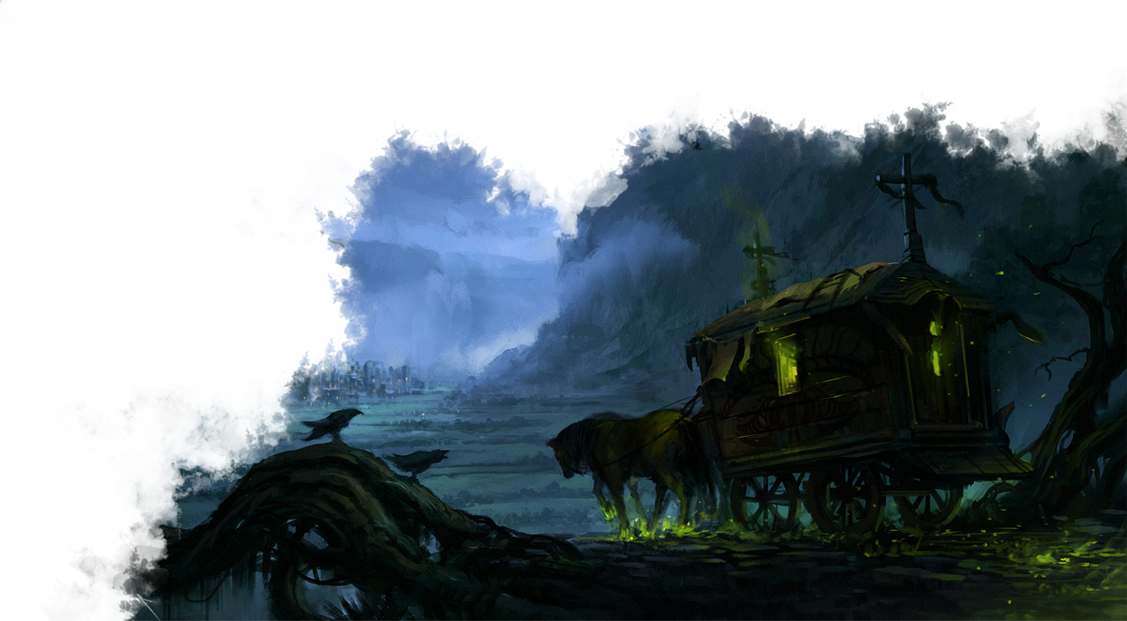
Animator Style
At 10th level, you gain one of the following features of your choice:
Adept Awakener
Undead Minions raised by you may now make up to two attacks per turn, provided that the original creature had the ‘multiattack’ property. Additionally, your Undead Minions no longer take a penalty to their ability scores when you raise them. Finally, when determining an Undead Minion's hit points upon raising it, you may now choose to expend three hit dice instead of two.
Giant Rouser
You are now able to create Undead Minions out of corpses of large and huge-sized creatures, as well as out of creatures of the celestial, dragon, fey, fiend and giant types. Additionally, the maximum CR of creatures you can raise becomes equal to your Necromancer level plus your wisdom modifer. Finally, your Undead Minions can now ascend and descend freely while flying, though their original flight speed is still halved.
Undead Magnate
Your Undead Minions now last indefinitely and you can control a number of Undead Minions equal to your proficiency bonus before newer ones cause older ones to collapse, but you no longer add twice your Necromancer level to the result of the expended hit dice when determining a Undead Minion's hit points upon raising it. The Conduit Walkers feature may be used to deliver touch spells through any one of your Undead Minions.
Still Life
At 14th level, you become so adept at raising undead that you gain a certain amount of control over how they appear. When raising an Undead Minion or when casting the Animate Dead or Create Undead spells, you are able to dictate the looks of the creatures you create as if they were casting a Disguise Self spell on themselves. When a creature is disguised in this way, the changes made are permanent rather than being bound to a one hour duration.
Legendary Animator
At 20th level, you may pick an additional Animator Style from the ‘Animator Style’ archetype feature.
Tip for DMs:
Initially, the Undead Minion feature may seem daunting and confusing, but it ends up playing out a lot simpler than it looks: most of text above simply establishes limits to what a Minion can do. Generally, when a player raises a minion, all that should be required from your end is to give them access to the stat block. From this point, they take a -2 penalty to all saving throws, their 'to hit' for attack rolls, their damage rolls, and their AC as long as the creature does not wear heavy armor. You can then roleplay the creature to your liking - or not at all. If there is ever any question as to whether a certain minion would be able to perform a specific type of action, the final decision is yours.
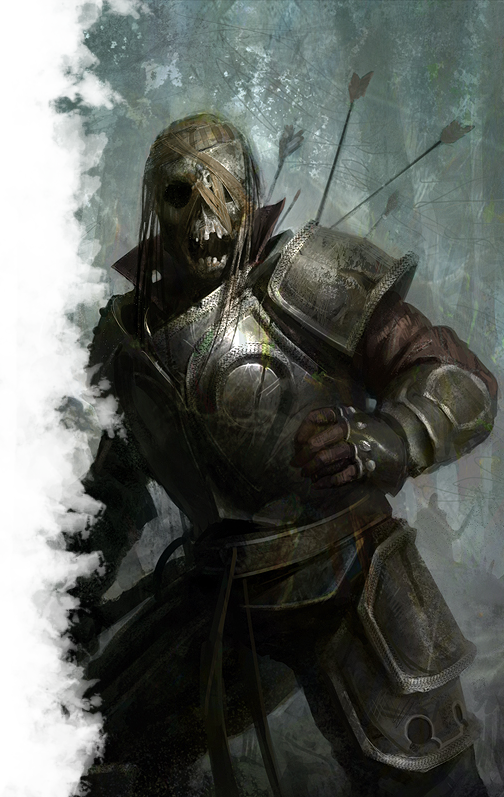
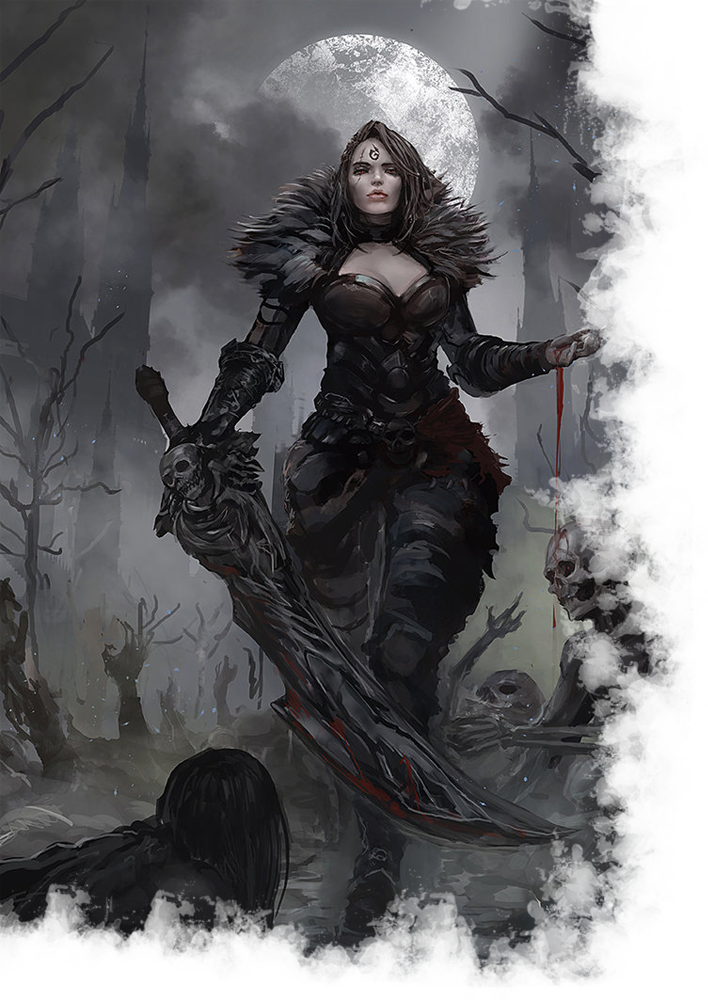
The Creed of the Siphon
If manipulating the essence of life is a skill, the Creed of the Siphon has turned it into an art form. Necromancers who veer in this direction spend most of their time practicing and honing their life-altering techniques, to a point where they gain an uncanny control over both their own health, and that of their enemies - or allies, if they so desire. Some continue to practice this skill through spells and prefer to fight from a distance, while others pick up a weapon and channel their siphoning skills in melee combat.
Sycophant
At 2nd level, you have obtained a greater control over the life essence all necromancers manipulate, allowing you to steal it from others and imbue yourself with it. Whenever you deal necrotic damage, you automatically regain hit points equal to one third of the necrotic damage dealt, rounded down.
Additionally, you gain proficiency in medium armor, shields, and three weapons of your choice.
Learned Siphoner
At 6th level, whenever you deal damage with a weapon attack or any necromancer spell, you can choose to change the damage dealt to be of the necrotic type. Additionally, you gain one of the following features of your choice:
Essence Weaver
Whenever you cast a spell of 5th level or lower that causes one or more creatures to regain hit points, you may choose to make the spell target one additional creature that you can see within 60 feet, which must make a constitution saving throw against your spell save DC. The target takes necrotic damage instead of regaining hit points on a failed save, or half as much damage on a successful one.
Additionally, whenever you would regain hit points through the use of your Sycophant trait, you may choose a target within 60 feet of you that you can see. They then regain hit points instead of you.
Vigor Thief
While wielding a weapon, you can use an action to target up to four creatures within 60 feet that you can see. These targets must each make a constitution saving throw against your spell save DC. You deal necrotic damage equal to three times your necromancer level, spread out equally among all targets that fail their save, rounded down. If all targets succeed on their saving throw, no damage is dealt.
You can choose not to regain hit points from this damage through the sycophant trait. If you do so, you store the lifeforce stolen in your weapon instead: the next time you use your Vitality Shift feature before the end of your next long rest, whichever target gains hit points also receives additional hit points equal to the damage that was just dealt.
Once you use this feature, you must finish a long rest before you can use it again.
Ascetic Dominion
At 10th level, your mastery over life-essence allows you to bring back even the recently deceased. You may use the Vitality Shift feature to grant hit points to a target that has died within the past 24 hours to bring them back to life. Whenever you do so, your target suffers from a level of exhaustion (as described in PHB appendix A).
Everlasting
At 14th level, whenever you fall unconscious, you no longer lose your senses, instead experiencing the world around you as a life-like dream. Whenever you would make a death saving throw, you can instead choose to sap energy from your surroundings, causing you to gain 1 hit point. Once you use this feature, you can’t use it again until you finish a long rest.
Bloodfunnel
At 20th level, your Vitality Shift feature gains a range of up to 60 feet. Additionally, you may target unwilling creatures with it, at half the effectiveness. Whenever you attempt to do so, your target makes a constitution saving throw against your spell save DC, and a charge of Vitality Shift is expended. On a success, nothing happens. On a failed save, you can take or give them hit points up to twice your necromancer level.
The Creed of Tomes
Though necromancy is an innate skill and not a learned one, the techniques with which the skill is applied can be improved through the learning of theoretical substance. This is the tenet that those of the Creed of Tomes take to heart. Rather than perfecting their practical ability to manipulate life essence, they would study the art of spellcasting and use those techniques to reinforce their natural abilities. As such, these types of necromancers tend to be the most learned ones, having the widest array of spells available to them and uncovering secret ancient techniques that few are aware of.
Initiate of the Tome
At 2nd level, you become an initiate in the Creed of Tomes and obtain a necromantic tome. As long as this tome is on your person, you gain the following benefits:
- You may cast the Prestidigitation cantrip as if you have it known, without it counting towards your cantrips known.
- You may cast the Mage Armor spell as if you have it known, without it counting towards your spells known.
- Whenever you cast a necromancer spell of at most 5th level, you may use your bonus action to make it a refined spell. Whenever you do so, add your intelligence modifier to any attack rolls made as part of the spell, and to the DC of any saving throw prompted by it. Once you use this feature, you can’t use it again until you finish a long rest.
- You may use the tome as a spellcasting focus for your necromancer spells
Should your necromantic tome be lost or destroyed, you are able to create a new one. This process costs 20 gp and 2 hours of time for each necromancer level you possess.
Arcane Shift
Also starting at 2nd level, when using the Vitality Shift feature on a target who has the Spellcasting feature, you may choose to exchange one used spell slot of 5th level or lower for an unspent one of equal level instead of transferring hit points between you and your target. Similarly to hit points, this exchange can go in either direction, and neither you nor your target can obtain more spell slots than listed in your respective class tables.
Augur’s Acumen
At 3rd level, you unlock the Augur’s Acumen perks detailed at the end of the class description, and gain one of these immediately. When you gain certain necromancer levels, you gain additional Acumens of your choice, as shown in the ‘Acumens Known’ column of the necromancer table. Once obtained, you permanently gain the benefits of an Acumen.
Evercasting
At 20th level, you have learned how to morph life essence into magical energy when dealing a killing blow through magic. Whenever you use a spell to kill any number of creatures with a combined CR of 10 or higher, you regain one spell slot of any level up to 5.
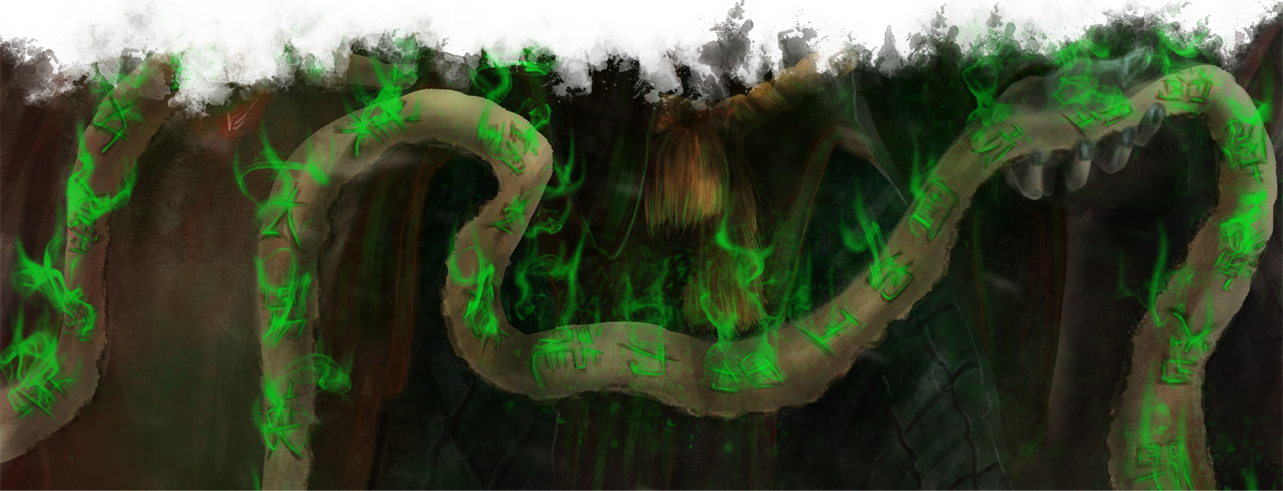
Augur’s Acumen Perks
If an Augur’s Acumen has prerequisites, you must meet them to acquire it. You can learn the Acumen at the same time that you meet its prerequisites.
Black Ice
You learn the Armor of Agathys spell, without it counting against your spells known.
Additionally, whenever a creature takes damage from your Armor of Agathys spell, add your wisdom modifier to the damage the creature takes. A creature damaged this way cannot take any reactions until the start of its next turn.
Channeler
You learn how to be constantly aware of traces of life energy surrounding you. While you are conscious, you are always aware of any non-construct close to you, out to a radius of 10 feet. This includes creatures on the ethereal plane.
Dark Aegis
Prerequisite: 14th level
You can cast Dispel Evil and Good at will, without expending a spell slot. Once you use this feature, you can’t use it again until you finish a long rest.
Fervor of the Lost
Prerequisite: 6th level
Your studies have taught you about some simple rituals to brace your own life force. Whenever you would roll a hit die, you may choose to forego the roll entirely and instead proceed as if you had rolled the maximum amount.
Galerider
Prerequisite: 14th level
Through long hours of study, you have managed to master the ancient art of passive magical floating. Rather than walking, you gain the ability to glide one foot above the ground, allowing you to pass over difficult terrain that does not rise above that height without taking a movement penalty, and allowing you to move over liquid surfaces as if they were solid ground.
Additionally, while floating, you do not trigger any non-magical traps activated by floor-based mechanisms such as pressure plates. Otherwise, you move normally, as if you were walking. You can choose to activate or deactivate this ability at will, though it will disable immediately if no solid ground is within 1 foot beneath you. You cannot prevent fall damage through floating.
Intuitive Anatomy
As an action, you can examine a creature that isn’t a construct or elemental, or the corpse of any such creature. Whenever you do so, you learn the type of the creature you examined (aberration, fey, celestial, beast, etc.). Additionally, you make a Wisdom (Medicine) check, for which the DC is equal to 8 + the creature's CR (rounded up). On a success, you also learn the creature's current and maximum hit points.
Mark of Death
Prerequisite: 14th level
As an action, you can select a creature you can see and attempt to mark them for the grim reaper himself to collect. The target has to make a Constitution saving throw against your spell save DC. If it fails, for the next minute, it has disadvantage on all saving throws. On a success, the target is unaffected. You have to concentrate on maintaining this mark as if it were a spell, and once you use this feature, you can’t use it again until you finish a long rest.
Numbing Caress
Prerequisite: Chill Touch cantrip
Whenever you cast the Chill Touch cantrip, you may now use d10 for your damage dice, rather than d8.
For example, casting this spell as a 5th level necromancer will cause 2d10 damage on a hit, rather than 2d8.
Religious Familiarity
Prerequisite: 10th level
Your studies of death have made you a learned man when it comes to religion and religious views on the afterlife. You learn the basic tenets of all but the most obscure sects, as well as the symbolism and rites they use and adhere to, and their general spheres of influence. As such, you have advantage on Charisma (Deception) checks made trying to pass yourself off as an acolyte of any religion, and you have advantage on any Wisdom (Insight) or Intelligence (Investigation) checks made trying to uncover with which religion a creature or location is aligned.
Seance
Prerequisite: 6th level
You learn how to contact the spirits around you. During a short or long rest you can perform a brief ritual. When doing so, you become aware of all intelligent beings that have died within the last 100 years within a 1 mile radius around your position, and you learn the general causes of their death (‘a fight’, ‘famine’, ‘a fire’, 'natural', etc). This causes you to gain advantage on Intelligence (History) checks regarding events that happened within this area in the past 100 years for as long as you remain within the 1 mile radius.
Once you use this feature, you can’t use it again until you finish a long rest, and you can’t hold a Seance within the same area again for 7 days.
Shadowstep
Prerequisite: 10th level
You learn the Misty Step spell, without it counting against your spells known.
Soulscrying
Prerequisite: 10th level
As an action, you can open your mind to all souls within a 1 mile radius around you. Whenever you do so, you instantly become aware of all living creatures within this range, allowing you to gauge exactly how many creatures are near you, and where they are at the moment of the sensing. You can tell the difference between creatures of different sizes, but are unable to differentiate between the souls you sense in any other way. Once you use this feature, you can’t use it again until you finish a short or long rest.
Spectral Manipulation
Prerequisite: Sword Burst cantrip
When you cast Sword Burst, its range is 20 feet, and friendly targets automatically succeed on the saving throw.
Spirit Sight
Prerequisite: 6th level
You can instantly cast Clairvoyance at will, without expending a spell slot or requiring casting time. Once you use this feature, you can’t use it again until you finish a long rest.
Twinned Fate
Prerequisite: 10th level
You can use an action to attempt to bind your fate to that of any creature you can see within 60 feet. The target has to succeed on a Constitution saving throw against your spell save DC or become bound to you for 1 minute - willing targets can choose to fail on purpose.
While you are bound, whenever either you or your target is affected by a phenomenon that prompts a saving throw, the other is also subjected to the its effects, as if they were targeted as well. They make the same saving throw, using their own saving throw bonuses. If your bound target attains a different result than you do, you can choose to either change your own result to theirs, or change their result to your own. For example: if your bound target makes their saving throw and you would fail, you can choose to copy their success instead.
A creature being immune to a certain effect counts as it automatically succeeding on the saving throw, and this ability cannot cause a creature to become frightened by itself. Once you use this feature, you can’t use it again until you finish a long rest.
Vice of the Lifeless
Prerequisite: 6th level
Using ancient books as your guide, you have perfected the art of communicating with the deceased. You learn the Speak with Dead spell without without it counting against your known spells.
Additionally, you are able to cast the spell on targets that no longer have a mouth, causing you to hear their voice in your head instead. Whenever you use the spell, the target is forced to answer each of your questions and they cannot lie when doing so, though they can still be brief, repetitive or cryptic.
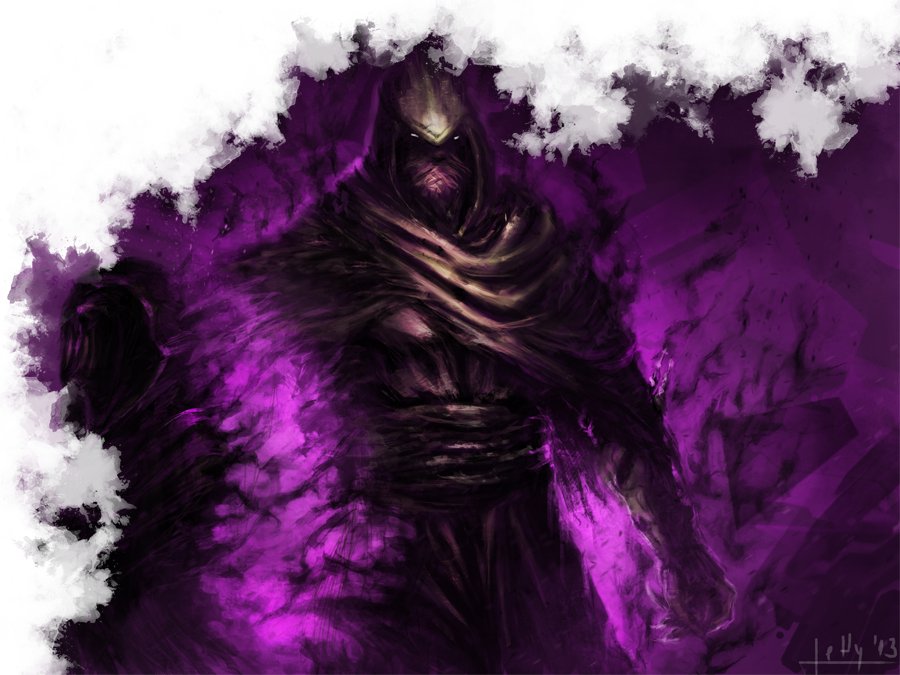
Necromancer Spell List
- (SC) designates that the spell is from the Sword Coast Adventurer’s Guide
- (XG) designates that the spell is from Xanathar's Guide to Everything
===============================================================================================
Cantrips (0 Level)
- Acid Splash
- Chill Touch
- Dancing Lights
- Frostbite (XG)
- Green-Flame Blade (SC)
- Infestation (XG)
- Mold Earth (XG)
- Poison Spray
- Ray of Frost
- Spare the Dying
- Sword Burst (SC)
- Thaumaturgy
- Toll the Dead (XG)
- True Strike
1st Level
- Bane
- Cause Fear (XG)
- Command
- Cure Wounds
- Detect Evil and Good
- Detect Poison and Disease
- Disguise Self
- False Life
- Healing Word
- Inflict Wounds
- Protection from Evil and Good
- Shield
- Ray of Sickness
2nd level
- Aid
- Augury
- Blindness/Deafness
- Blur
- Darkness
- Find Steed
- Gentle Repose
- Lesser Restoration
- Moonbeam
- See Invisibility
- Shadow Blade (XG)
- Phantasmal Force
- Prayer of Healing
- Ray of Enfeeblement
3rd Level
- Animate Dead
- Beacon of Hope
- Bestow Curse
- Blink
- Fear
- Feign Death
- Gaseous Form
- Magic Circle
- Mass Healing Word
- Phantom Steed
- Remove Curse
- Revivify
- Speak With Dead
- Spirit Guardians
- Vampiric Touch
4th Level
- Arcane Eye
- Aura of Life
- Blight
- Death Ward
- Locate Creature
- Mordenkainen’s Faithful Hound
- Phantasmal Killer
- Shadow of Moil (XG)
- Sickening Radiance (XG)
5th Level
- Antilife Shell
- Cloudkill
- Contagion
- Danse Macabre (XG)
- Dream
- Enervation (XG)
- Greater Restoration
- Hallow
- Insect Plague
- Mass Cure Wounds
- Negative Energy Flood
- Raise Dead
- Rary's Telepathic Bond
- Reincarnate
6th Level
- Circle of Death
- Create Undead
- Disintegrate
- Eyebite
- Harm
- Heal
- Magic Jar
- Move Earth
- Soul Cage
- True Seeing
7th Level
- Divine Word
- Etherealness
- Finger of Death
- Regenerate
- Resurrection
- Symbol
8th Level
- Abi Dalzim’s Horrid Wilting (XG)
- Clone
- Demiplane
- Feeblemind
9th Level
- Astral Projection
- Power Word Heal
- Power Word Kill
- True Resurrection
Multiclassing
In order to qualify for a multiclass combination including the
necromancer class, you must meet the following requirement:
- Have a wisdom of score of 13 or higher
You gain proficiency in light armor when doing so.
Credits
Version: 2.0 (12-12-2018)
Made by /u/Mozared in GM Binder. Thanks to
/u/SingleCelledPsyk for assisting with a transition from Google
Docs, and to Maity for his feedback and ideas. Art used with
permission or as stock by: Mathias Zamęcki, Fantasystock,
ChrisCold, Jorge Jacinto, Kingkostas, CGlas, LetticiaMaer and
MorkarDFC, in order of placement.
